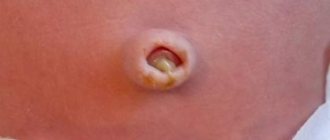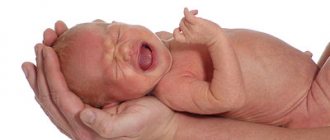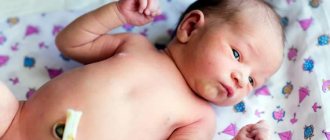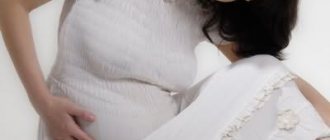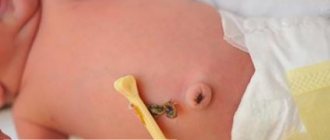An inconspicuous part of the body, the navel, can cause considerable problems for a person. The navel is a scar left after the umbilical cord dries out. A wet navel can indicate serious illnesses that cannot be dealt with without medical help. The scar becomes hyperemic, swollen, and fluid leaks from it. If you notice this, do not delay treatment.
A wet navel signals serious illnesses that cannot be treated without medical help.
Why does a baby's belly button start to get wet?
A wet belly button affects its healing time. The ichor appears due to improper care of the wound, non-compliance with hygiene rules, technique and regularity of treatment. So, the navel will not heal well if you treat it with expired medications, unwashed hands and unsterile materials. Under such conditions, germs and infection quickly penetrate the infant's body. And since the baby’s immunity is not strong enough, the infection actively spreads, affecting not only the umbilical area, but also the internal organs.
Among the reasons why the navel begins to get wet, the main ones are:
- non-compliance with hygiene rules: untimely change of diapers, removal of the protective crust from the navel, regular wetting of the wound when bathing or washing;
- infection of the wound due to early placement of the baby on the tummy: the navel may begin to rot and smell bad if staphylococcus or E. coli gets into it;
- weakened immune system;
- when the umbilical cord falls off, a deep wound forms in its place, and it can heal according to the individual characteristics of the baby;
- poor blood clotting process, due to which a crust on the wound forms slowly and ichor is released abundantly;
- overzealous treatment of the navel with antiseptics, which do not allow the wound to dry and lead to burns.
If you find that your baby's navel is moist or damp, immediately consult a pediatrician - a specialist will tell you how to properly care for the umbilical cord and point out your mistakes.
What to do
If the umbilical wound begins to smell bad or there is discharge, consult a doctor. The pediatrician will prescribe a course of treatment with antimicrobial ointments, prescribe antibiotics, and adjust the infant hygiene procedure. At the same time, you need to follow simple rules for caring for your navel so that it heals faster:
- If the wound becomes wet, inflamed and rotting, avoid bathing. Water can be a source of infection.
- Pour hydrogen peroxide onto the non-healing area and wait until it sizzles. Then pat the wound dry with a tissue.
- Lubricate the skin around the wound and inside with brilliant green or drip two drops of Chlorophyllipt alcohol solution.
- Apply Fukortsin and Baneocin to the weeping wound. These agents have antifungal and antiseptic effects. "Baneocin" is especially useful for weeping navels, contains two types of antibiotics, and is well tolerated by newborns. After a course of using these drugs, the navel heals quickly, crusts form on the wound, and they disappear on their own after a few days.
- If the navel becomes wet, if it begins to stink, carry out the procedure of drying and treating with antiseptics at least twice a day.
What can be the complications of a weeping navel?
A long healing process of the navel may indicate the development of pathologies such as:
- Dermatitis. Redness forms around the navel as a reaction to hygiene products and items (antiseptics, wipes, creams). Dermatitis can be triggered by high room temperatures: due to the fact that the child often sweats, the navel may become more wet. Treatment in this case is simple: all you need to do is adjust the air temperature to 18-200C and eliminate previously used hygiene products.
- Omphalitis. Pathology can develop a month after the birth of a baby. With omphalitis, the umbilical wound, as well as the area around it, begins to become wet and rot. The cause of the disease is poor care of the newborn and the use of non-sterile hygiene products.
- Fistula. If there is a defect in the structure of the abdominal muscles of the child, a fistula may appear, which connects the baby’s navel with other organs (for example, the intestines, bladder). If the navel begins to smell bad, and the unpleasant odor is accompanied by an increase in body temperature, an increase in the navel in diameter and the appearance of copious discharge from the wound with heavy crying or defecation, there is a high probability that the baby has a fistula. With its full type, surgical treatment is required. If it is incomplete, there is a chance that by 6 months the fistula will disappear on its own.
- Sepsis (blood poisoning) is a dangerous complication of the condition when the navel continues to get wet, and parents do not want to do anything about this problem for a long period of time. Sepsis can be fatal if you do not seek medical help in time, since the infection that enters the infant’s body quickly penetrates the baby’s blood and spreads through vital systems.
Remember that a newborn baby is very vulnerable to any disease, so you need to treat the navel very responsibly.
Possible reasons
An unpleasant odor from the umbilical wound in a newborn is, of course, not the norm, but it is also not always a sign of serious problems with the child’s health. There are several reasons for this phenomenon:
- Long-term healing of the umbilical wound. Normally, the navel heals within a few weeks after the baby is born. If the process drags on, secretions, sputum, and sometimes blood accumulate inside the umbilical wound.
- Umbilical fistula in a newborn. An extremely unpleasant pathology associated with the direct connection of the umbilical opening with the abdominal organs. In this disease, waste products and blood are released through the navel, and suppuration forms inside the wound. The problem can be solved quickly; you definitely won’t be able to get by with brilliant green.
- Insufficient care. If the mother does not treat the wound well, dirt, discharge, ichor remain inside, irritation begins, and the navel smells bad. With proper care there should not be any unpleasant symptoms.
When should you seek help from a clinic?
Parents should be alert to the following signs of a weeping navel:
- the umbilical wound stops healing and, on the contrary, becomes more inflamed;
- the wound continues to get wet, fluid with blood or pus is released from it;
- the baby becomes restless, eats poorly, sleeps poorly, looks sick, his body temperature rises, etc.;
- swelling and redness of the area around the navel appears;
- long period of healing of the navel - more than 3 weeks;
- After treatment, the ichor does not dry out for a long time, and a crust does not form on the wound.
At the initial stage of complications, the newborn may feel well. But as soon as the wound becomes infected and the disease takes on a more complex form, the baby begins to be capricious, cry, eat poorly and sleep poorly. Therefore, responsible parents cannot ignore the problem.
Why does an unpleasant odor occur?
The cause of such an unpleasant phenomenon as the smell from the navel, oddly enough, is physiology.
The whole point is that the artery passing through the umbilical ring puts strong pressure on the baby's intestines. This occurs due to the constant crying of the newborn.
Since the umbilical cord has not yet fully tightened, this is the cause of this unpleasant phenomenon. This is a fairly common reason. There's nothing wrong with that. The most important thing is to treat the wound regularly. It is necessary to ensure that the navel does not get wet, but heals quickly.
Another cause of bad odor from the navel is an umbilical fistula. This is the most dangerous and serious reason of all. This is due to the fact that the fistula can only be removed surgically. Along with an unpleasant aroma, liquid with impurities of pus is released.
Often, due to improper treatment of the navel, an odor may also appear. A large amount of liquid, ichor, is gradually released. An infection gets into the wound, which causes an unpleasant odor.
As a rule, after the remainder of the umbilical cord falls off, minimal fluid discharge is still acceptable. However, its amount should gradually decrease, and not vice versa. Parents should monitor the healing process. Subsequently, the wound will become smaller.
It should be noted that a bad smell does not always lead to negative consequences. When it is detected, you need to pay attention to additional symptoms.
How to properly care for your navel?
Every mother receives similar instructions upon discharge from the maternity hospital. So, to care for the umbilical wound, you need to have brilliant green, sterile cotton wool, hydrogen peroxide and a pipette with you. Treat the navel twice a day until it is completely closed. The procedure should be as follows:
- Wash your hands thoroughly using antibacterial or laundry soap.
- Undress the child, examine the wound, pay attention to its smell - it should be absent.
- Using a pipette, drop a little peroxide into the wound. Wait until it dries or after a few minutes remove it with a cotton swab or pad. Perform all actions very carefully!
- Use a pipette to take a little greenery and drop it into the umbilical wound.
- When the green stuff dries, dress the baby without covering the navel with a diaper.
Pediatricians do not recommend putting pants on a newborn until the navel has healed.
How to properly do an enema for newborns with constipation?
Should you vaccinate your child: pros and cons
How to collect urine from an infant for analysis?
Diagnosis and treatment
Diagnosis of the disease necessarily includes visual examination and palpation of the navel
If a child's navel is oozing, an urgent examination by a pediatrician and surgeon is necessary. The doctor will make the correct diagnosis and prescribe individual methods of therapy. Diagnostic steps include:
- visual inspection and palpation;
- analysis of urine and blood for the presence of inflammation and identification of the pathogen.
If a large area of epithelial tissue is affected, an additional ultrasound may be prescribed to determine the condition and nature of the pathology.
Features of treatment
Broad-spectrum penicillin antibiotic
Therapy depends on the baby's condition. The bacterial process must be stopped with antibiotics; poor hygiene is corrected by prescribing antibacterial drugs for treating the navel.
If an inflammatory process occurs, E. Komarovsky recommends drugs such as Flemoxin, Amoxiclav or Augmentin. The dosage is prescribed by a specialist depending on the child’s body weight. At the same time, treatment with antiseptics according to the algorithm is mandatory.
- Wash your hands thoroughly with soap before touching the umbilical wound.
- Add a few drops of hydrogen peroxide or Miramistin.
- We wait until the contents in the wound get a little wet, then use a sterile cotton swab to remove all the moisture.
- We take a pipette and take a couple of drops of brilliant green and treat the navel.
Never cover a baby's wet navel with a bactericidal plaster. Once dry, the contents may stick to the sticky surface. When removed, there is a risk of damaging the wound and causing bleeding.
Chlorophyllipt is an effective local remedy that is used for skin damage and inflammation.
It is recommended to treat the navel of infants daily after each bath. Be sure to combine the procedure with air baths.
Treatment of a weeping navel in a newborn can be carried out with the following drugs:
- Chlorophyllipt. Disinfectant prepared on the basis of medicinal plants. Promotes the destruction of pathogenic microorganisms, while simultaneously creating a drying effect. Can be used instead of hydrogen peroxide.
- Baneocin. Can be used in powder or ointment form. Suitable for treating the umbilical wound in the maternity hospital. It has a strong drying property, so it is important not to overdo it with application.
- Furacilin. Prescribed for the navel if it gets wet and does not dry out on its own. The tablet is dissolved in a glass of warm water, after which the wound is treated.
- Xeroform. Designed for the last stage of treatment of the umbilical wound. It can be used morning and evening. Quickly has a drying effect.
In the presence of a serious inflammatory process, therapy should be comprehensive: along with treatment, injections or droppers with antibiotics are prescribed.


